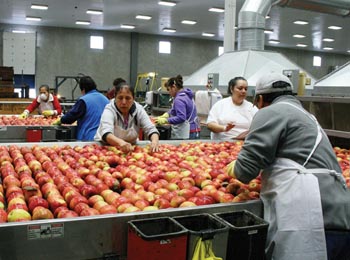Robots scan the barcodes of packed boxes of apples and stack 49 on each pallet, ready for shipping.
Photos by Geraldine Warner
The owners of Washington Fruit and Produce Company have a vision of the apple industry of the future. There will be bigger crops but fewer packers. Food safety and traceability will be more critical, buyers will be more demanding about fruit quality, and worker safety regulations will require electric forklifts.
Their new $30-million apple packing facility at River Road, Yakima, Washington, is designed to address all those issues and more. In fact, company president Rick Plath believes it’s one of the largest and most advanced packing lines in the world.
The new plant is a third larger than Washington Fruit’s old apple packing facility at First Avenue, Yakima, and will be able to accommodate more apples from the company’s young apple orchards in the Columbia Basin that are starting to come into production. It can handle about 400,000 bins (7 million boxes) of apples annually. Two-thirds of the apples the company packs come from its own orchards.
Although the older packing facility was just 18 years old, it was technologically outmoded and has been mothballed by the company.
“The retailers want to buy with confidence from modern, clean plants,” said Plath, who thinks the new plant, which has been operating since November, will help keep the company competitive. It’s bigger, brighter, cleaner, and more efficient than the old one.
Tom Hanses, operations manager, said that Washington Fruit started with the number-one goal of improving fruit quality. He and his colleagues travelled around the world looking at different packing lines and picked out the best components of each.
They began by deciding how many bins per hour they wanted to pack, and then selected the electronic grader and sizer, which was supplied by the New Zealand company Compac. The packing line was built around the sizer, and the walls around the packing line. The packing facility covers 110,000 square feet, and a similar area is devoted to storage of packed fruit. It operates 120 hours a week.
Hanses said the company had been thinking of upgrading for four or five years. When they eventually decided to take the plunge, the timing was good because they were able to include the latest electronic grading and sizing equipment, as well as infrared sorting for internal quality. Some customers specify a soluble solids level.
They were also able to include five robots to palletize the packed boxes. Robots tend to handle fruit more gently and consistently than a human forklift driver, Hanses said, and a bonus has been increased efficiency.
“Even though it’s 20 percent more efficient, that’s not the reason we used this modern technology,” he said. “We have a more consistent box day in and day out than we were able to have with the old packing line.”
Almost all the systems are automated, from the quick-opening doors to the bagging line and beyond. Apples are tracked from arrival to departure with bar codes and each packed box has a unique identity. On the loading dock, forklifts have computers on board so that drivers can scan the loading sheets and retrieve the correct fruit from storage for each truckload.
When the previous line was built, it had a team of eight welders and no laptop computer, Plath noted. “For this one, there were eight laptops and one welder.”
 One of the striking features of the new plant is the amount of light. It has skylights and bright lighting throughout. The light level is between 145 and 160 foot-candles over the sorting tables and 70 foot-candles throughout the rest of the plant, compared with only 30 foot-candles of ambient light in the old packing plant.
One of the striking features of the new plant is the amount of light. It has skylights and bright lighting throughout. The light level is between 145 and 160 foot-candles over the sorting tables and 70 foot-candles throughout the rest of the plant, compared with only 30 foot-candles of ambient light in the old packing plant.
The company is SQF 2000 certified. The light fixtures are recessed in the ceiling, rather than hanging, so that there are no surfaces to gather dust. The sprinkler system pipes and electrical system are also enclosed, which is an important food safety issue.
Plath said the company doesn’t expect to see a direct return on its $30-million investment in the new facility. “I don’t think it’s going to make us any money,” he said. “It’s just a cost of doing business. It’s 2011 right now, and that’s what this looks like.”
“If you’re not moving forward, you’re not standing still—you’re moving backwards,” Hanses added.

Leave A Comment